Body Movements Class 6 Worksheet Science
| Table of contents |

|
| Fill in the Blanks |

|
| Match the Following |

|
| True or False |

|
| Answer the following |

|
| Assertion and Reason Questions |

|
Fill in the Blanks
Q1: We are able to bend or rotate our body only at .
Ans: joints
We are only able to bend or rotate our body at joints. Joints are the specific locations where movement is possible, such as the elbow, knee, or shoulder.
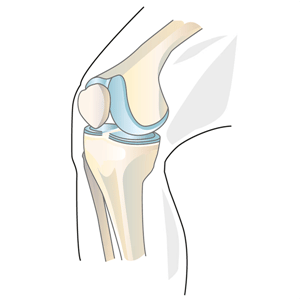 Joint
Joint
Q2: Bones and forms skeleton of the human body.
Ans: cartilage
Bones and cartilage together form the skeleton of the human body. Bones provide the structure and support, while cartilage covers the ends of bones and acts as a cushion between them.
Q3: gives frame and shape to our body and helps in movement.
Ans: Skeleton
The skeleton gives our body its frame and shape. It provides support for our muscles, organs, and tissues, and also plays a crucial role in movement by serving as attachment points for muscles.
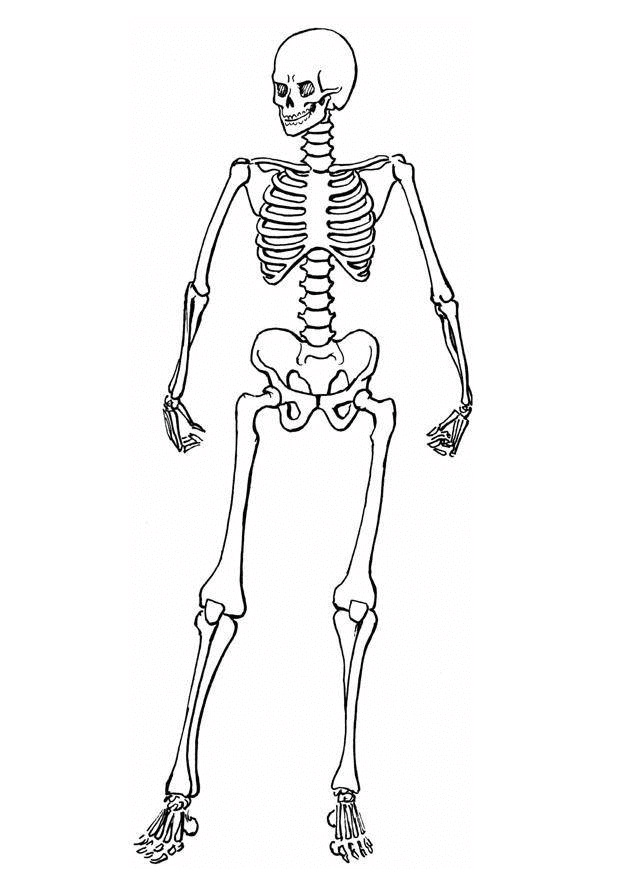 Skeleton
Skeleton
Q4: In a joint a cylindrical bone rotates in a ring.
Ans: pivotal
In a pivotal joint, a cylindrical bone rotates within a ring-shaped structure. This type of joint allows for rotational movement, such as the rotation of the head or the twisting of the forearm.
Q5: images are used to find out about any possible injuries that might have happened to the bones.
Ans: X-ray
X-ray images are commonly used to identify and evaluate any possible injuries that may have occurred to the bones. X-rays can provide detailed images of the internal structure of bones, helping doctors diagnose fractures, dislocations, or other bone-related issues.
Q6: protects brain.
Ans: Skull
The skull is the protective structure that encloses and protects the brain. It is made up of several bones that fit together to form a strong and sturdy casing around the brain, helping to prevent injuries to this vital organ.
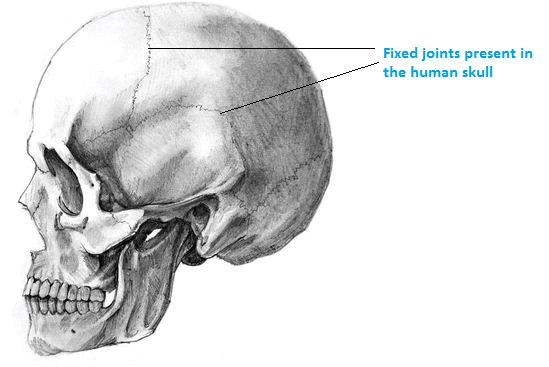 Skull
Skull
Q7: Our skeleton is made up of many , joints and cartilage.
Ans: bones
Our skeleton is composed of many bones, joints, and cartilage. The bones provide the framework, the joints allow for movement, and the cartilage acts as a cushion and reduces friction between bones.
Q8: The rounded structure a snail carries on its back is called .
Ans: shell.
The rounded structure that a snail carries on its back is called a shell. The shell is made up of calcium carbonate and provides protection and support for the snail's body.
Q9: on the body of fish mainly helps to keep the balance of their body.
Ans: Fins
Fins on the body of fish primarily help to maintain balance and stability. Fins provide control and maneuverability in water, allowing fish to swim and change direction efficiently.
Q10: Snakes have a backbone.
Ans: long
Snakes have a long, flexible backbone. This allows them to move in a unique way by bending and flexing their body in various directions. Their backbone is made up of numerous vertebrae, enabling them to slither and coil.
Q11: Snails move with the help of a .
Ans: muscular foot
Snails move with the help of a muscular foot. The foot is a specialized organ located on the underside of the snail's body. It contracts and expands, creating a gliding motion that allows the snail to move. The foot also secretes mucus, which helps the snail glide smoothly over surfaces.
Match the Following
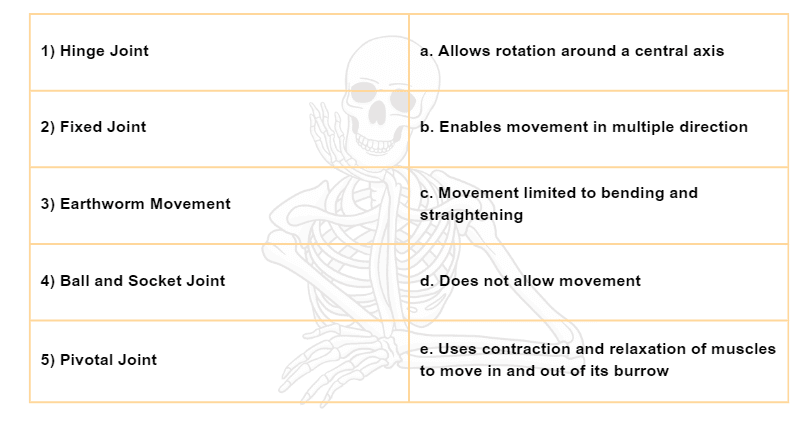
Ans:
1) Hinge Joint - c. Movement limited to bending and straightening
2) Fixed Joint - d. Does not allow movement
3) Earthworm Movement - e. Uses contraction and relaxation of muscles to move in and out of its burrow
4) Ball and Socket Joint - b. Enables movement in multiple directions
5) Pivotal Joint - a. Allows rotation around a central axis
True or False
Q1: Bones cannot be bent.
Ans: True
This statement is true. Bones are hard and rigid structures that provide support and protection to the body. They are made up of a dense outer layer called cortical bone and a spongy inner layer called cancellous bone. Due to their composition and structure, bones do not have the ability to bend.
Q2: Hinge Joint allows movement in all directions.
Ans: False
This statement is false. A hinge joint, such as the knee or elbow joint, allows movement in only one direction, like the opening and closing of a door. It does not allow movement in all directions.
Q3: The elbow has a fixed joint.
Ans: False
This statement is false. The elbow joint is not fixed but is a hinge joint that allows bending and straightening of the arm. It consists of three bones: the humerus in the upper arm and the radius and ulna in the forearm.
Q4: The bone in our arm is joined to our shoulder by a ball-and-socket joint.
Ans: True
This statement is true. The bone in our arm, called the humerus, is joined to the shoulder by a ball and socket joint. This joint allows for a wide range of movement in all directions, including rotation.
Q5: The joint between the upper jaw and the rest of the head is moveable.
Ans: False
This statement is false. The joint between the upper jaw and the rest of the head, known as the temporomandibular joint (TMJ), is a moveable joint. It allows for movements like opening and closing the mouth, chewing, and talking.
Q6: Bones in our body form a framework to give shape to our body. This framework is known as the skeleton.
Ans: True
This statement is true. The bones in our body collectively form the skeleton, which provides support, protection, and structure to our body. It gives shape to our body and allows us to move.
Q7: Ribs join the chest bone and backbone together to form a box called a skeleton.
Ans: False
This statement is false. Ribs do not join the chest bone (sternum) and back bone (vertebrae) together to form a box called the skeleton. The rib cage consists of the ribs, sternum, and thoracic vertebrae, and it protects the vital organs such as the heart and lungs.
Q8: The skull is made of many bones joined together.
Ans: True
This statement is true. The skull is made up of many bones joined together by immovable joints called sutures. It consists of the cranial bones, which protect the brain, and the facial bones, which give shape to the face.
Q9: Cartilage is also found in the joints of the body.
Ans: True
This statement is true. Cartilage is a flexible connective tissue that is found in various parts of the body, including the joints. It acts as a cushion and reduces friction between bones in a joint.
Q10: Cockroaches have three pairs of wings attached to the breast.
Ans: False
This statement is false. Cockroaches have two pairs of wings, not three. The wings are attached to the thorax, not the breast.
Q11: The snake moves forward very fast and not in a straight line.
Ans: True
This statement is true. Snakes do not move in a straight line but rather in a series of lateral undulations. This allows them to move forward quickly, especially in environments with obstacles or uneven terrain.
Answer the following
Q1: Write names of two animals that can move without bones.
Ans: Snail and Earthworm
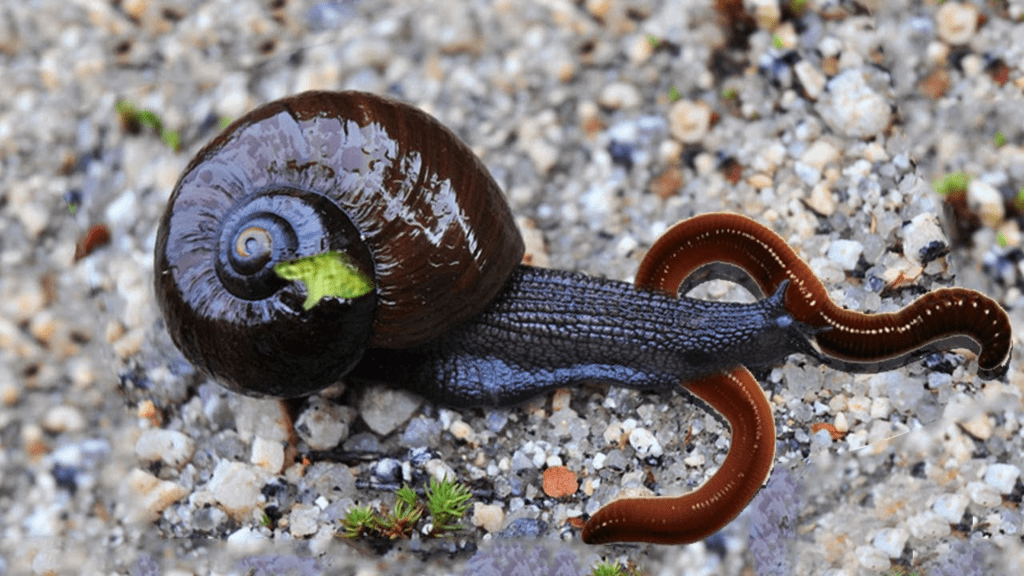 Snail and Earthworm
Snail and Earthworm
Q2: Write three animals that have streamlined bodies.
Ans: Fish, Whale, and Birds

Q3: Name one animal which can walk and climb as well as fly in the air.
Ans: Cockroaches
Q4: Name two birds that can swim in water.
Ans: Ducks and Swans
Q5: Name an aquatic animal whose skeleton is made entirely of cartilage.
Ans: Shark
Q6: Where is cartilage found?
Ans: Cartilage is found throughout our joints, bones, spine, lungs, ears, and nose.
Q7: What is a cavity in bones?
Ans: A cavity is a hollow space in the bones.
Q8: Which organs are protected by the rib cage?
Ans: The heart and lungs are protected by the rib cage.
Q9: What are ribs?
Ans: The ribs are thin, flat, curved bones that form the rib cage.
Q10: What is a skull?
Ans: The skull is made up of many bones joined together.
Q11: Name the organ that helps cockroaches in walking.
Ans: Cockroaches have three pairs of legs. These help in walking.
Q12: What is a bone?
Ans: Bone is the hard structure that forms the framework of our body.
Q13: Is it possible for us to bend our bodies at every point?
Ans: No, we can bend or move our body only at those points where bones meet.
Q14: If our body has no joints then will it be possible for us to move?
Ans: No, it will not be possible for us to move.
Q15: What would have happened if our body was made of single bone?
Ans: We would not be able to move if our body was made of a single bone.
Q16: Which type of joint is used when a cricket bowler balls the ball?
Ans: A ball and socket joint is used when a cricket bowler balls the ball.
Q17: What type of joint is used while lifting weights?
Ans: A hinge joint is used while lifting weights.
Q18: How many bones are present in our skull?
Ans: The human skull is generally considered to consist of twenty-two bones.
Assertion and Reason Questions
Q1: Assertion (A): Entire skeleton of shark is made of cartilage.
Reason (R): Cartilage is also found in joints in body.
(a) Both A and R are true and R is the correct explanation of A.
(b) Both A and R are true but R is not the correct explanation of A.
(c) A is true but R is false.
(d) A is false but R is true.
Ans: (b)
Assertion (A): The entire skeleton of a shark is made of cartilage. This is true because unlike most vertebrates, sharks have a skeleton composed of cartilage, which is lighter and more flexible than bone.
Reason (R): Cartilage is also found in joints in the body. This is true because cartilage is present in various joints in the human body, such as the knee and elbow, to cushion and reduce friction between bones.
Why R is not the correct explanation of A: Although R is true, it does not explain why the shark's entire skeleton is made of cartilage. The reason discusses the presence of cartilage in human joints, which is unrelated to why sharks have cartilaginous skeletons. The assertion and reason are both true, but R does not specifically explain the composition of a shark's skeleton.
Q2: Assertion (A): Shoulder is the region where fore limb or arm joins the body.
Reason (R): The two bones at the shoulder are called shoulder bones.
(a) Both A and R are true and R is the correct explanation of A.
(b) Both A and R are true but R is not the correct explanation of A.
(c) A is true but R is false.
(d) A is false but R is true.
Ans: (b)
Assertion (A): Shoulder is the region where the forelimb or arm joins the body.
Analysis: This statement is true. The shoulder is indeed the area where the arm connects to the body.
Reason (R): The two bones at the shoulder are called shoulder bones.
Analysis: This statement is somewhat misleading. The main bones involved at the shoulder are the clavicle (collarbone) and the scapula (shoulder blade). While you can refer to them as "shoulder bones," they are not typically called that in anatomical terminology.
Conclusion: Both statements are true, but the reason does not specifically clarify what "shoulder bones" are or correctly name them.
Therefore, the correct answer is: (b) Both A and R are true but R is not the correct explanation of A.
Q3: Assertion (A): Earthworm has muscles that help to extend or shorten the body.
Reason (R): Muscles can only pull and not push.
(a) Both A and R are true and R is the correct explanation of A.
(b) Both A and R are true but R is not the correct explanation of A.
(c) A is true but R is false.
(d) A is false but R is true.
Ans: (b)
Assertion (A): Earthworms have muscles that help them extend or shorten their bodies. This is true because earthworms have longitudinal and circular muscles that allow them to move by contracting and relaxing.
Reason (R): Muscles can only pull and not push. This is true in general because muscles work by contracting to pull on bones or other structures; they can't push.
Why R is not the correct explanation of A: While muscles can only pull, this fact doesn’t specifically explain how earthworms use their muscles to extend or shorten their bodies. The assertion describes the earthworm's movement mechanism, but the reason just states a general principle about muscle function.
Q4: Assertion (A): Cartilage covers the ends of bones.
Reason (R): Cartilage acts as a shock absorber and reduces friction between bones.
(a) Both A and R are true and R is the correct explanation of A.
(b) Both A and R are true but R is not the correct explanation of A.
(c) A is true but R is false.
(d) A is false but R is true.
Ans: (a)
Assertion (A): Cartilage covers the ends of bones.
This is true. Cartilage is a smooth, flexible tissue that covers the ends of bones in joints.Reason (R): Cartilage acts as a shock absorber and reduces friction between bones.
This is also true. Cartilage helps cushion the bones and allows them to move smoothly against each other, reducing friction and preventing damage.Why (a) is correct:
Both the assertion and the reason are true.
The reason explains why the assertion is true: Cartilage covers the ends of bones to reduce friction and absorb shock.
FAQs on Body Movements Class 6 Worksheet Science
| 1. What are the different types of body movements in humans? |  |
| 2. How do joints facilitate body movements? |  |
| 3. What is the significance of muscles in body movements? |  |
| 4. Can you explain the difference between voluntary and involuntary movements? |  |
| 5. How do body movements differ in animals compared to humans? |  |
















